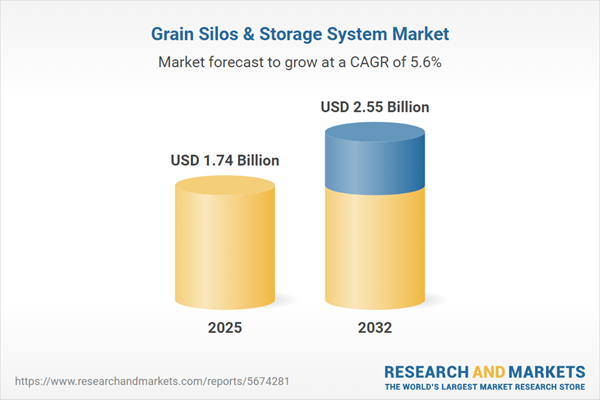Speak directly to the analyst to clarify any post sales queries you may have.
Senior leaders seeking deeper insight into the grain silos and storage system market will find a rapidly evolving landscape shaped by digital innovation, sustainability mandates, and dynamic global supply chains. This report equips decision-makers to navigate the latest trends and emerging risks within the sector.
Market Snapshot: Grain Silos & Storage System Market Growth
The Grain Silos & Storage System Market grew from USD 1.65 billion in 2024 to USD 1.74 billion in 2025, with a projected compound annual growth rate (CAGR) of 5.58%, reaching USD 2.55 billion by 2032. This trajectory reflects strong demand across modern agricultural infrastructure, increased focus on post-harvest loss mitigation, and ongoing investments in efficient inventory management aligned with global trends.
Scope & Segmentation of the Grain Storage Systems Market
The research provides comprehensive analysis and forecasting across multiple dimensions of the grain silos and storage system landscape. Core segmentation areas include:
- Product Types: Flat bottom, hopper bottom, and modular silos encompassing concrete, plastic, and steel configurations, each with distinct operational and deployment profiles.
- Capacity Ranges: Below 1,000 metric tons for smaller operators, 1,000–2,000 and 2,000–5,000 metric tons for commercial farming, and above 5,000 metric tons for industrial and export terminals.
- Material Options: Concrete for high stability, plastic for corrosion-resistance, and steel for rapid fabrication and structural strength.
- End Users: Agricultural producers, commercial distributors, and industrial processors, each driving unique requirements for throughput, compliance, and crop management.
- Installation Models: Offsite prefabrication or onsite assembly, selected based on local workforce, project timelines, and investment considerations.
- Regions Analyzed: Americas (including North and Latin America), Europe, Middle East & Africa (covering key European, Middle Eastern, and African markets), and Asia-Pacific (with deep dives on China, India, and major Southeast Asian countries).
- Companies Tracked: Evaluation includes industry leaders such as Ag Growth International Inc., Bühler AG, Sukup Manufacturing Co., Cimbria A/S, The GSI Group, Inc., and others driving innovation and market expansion.
Key Takeaways for Grain Silos and Storage System Market Players
- Modern grain silos are central to supply chain integration, blending smart design with automation and real-time monitoring to address quality assurance and operational efficiency goals.
- Sustainability imperatives drive adoption of eco-friendly materials, renewable energy integration, and intelligent monitoring platforms throughout the storage lifecycle.
- Climate-resilient storage options—including modular and adaptive capacity systems—help operators respond to yield unpredictability and weather volatility, strengthening supply chain continuity.
- End-to-end solution providers, as well as niche innovators, are reshaping the competitive landscape through technology partnerships, material advancements, and expanded services.
- Regional dynamics vary: North America leads in automation, Europe enforces stringent environmental compliance, while the Asia-Pacific market accelerates digital adoption and flexible capacity expansions.
Tariff Impact: United States Policy Effects in 2025
US tariffs introduced in 2025 on steel, concrete additives, and advanced sensors have altered input costs for stakeholders throughout the grain storage supply chain. Companies have responded by diversifying sourcing, optimizing procurement, and adjusting contractual terms, while exploring alternative composite materials to mitigate elevated costs and maintain project schedules. This shift fuels design innovation and encourages localization of supply where feasible.
Methodology & Data Sources
Findings are based on a blend of primary interviews and surveys with industry stakeholders, rigorous review of public and proprietary reports, regulatory documents, and technical journals. Advanced data analytics supports robust trend identification and cross-segment validation, ensuring perspective from both quantitative metrics and qualitative expert input.
Why This Report Matters
- Enables executives to evaluate strategic investments in next-generation storage technologies, including automation, digital monitoring, and sustainable materials.
- Arms procurement and operations leaders with actionable intelligence to mitigate risk from tariff fluctuations and evolving regional standards.
- Supports long-term planning by illuminating both disruptive and incremental trends shaping product, market, and supply chain evolution in the grain storage sector.
Conclusion
Strategic investment in digital integration, sustainable design, and supply chain resilience positions industry leaders for future growth. Market participants who align with evolving regulatory and technology trends will secure lasting competitive advantage in grain silos and storage systems.
Additional Product Information:
- Purchase of this report includes 1 year online access with quarterly updates.
- This report can be updated on request. Please contact our Customer Experience team using the Ask a Question widget on our website.
Table of Contents
3. Executive Summary
4. Market Overview
7. Cumulative Impact of Artificial Intelligence 2025
Companies Mentioned
The companies profiled in this Grain Silos & Storage System market report include:- Ag Growth International Inc.
- Bühler AG
- Sukup Manufacturing Co.
- Cimbria A/S
- Brock Grain Systems, Inc.
- The GSI Group, Inc.
- Ceretti & Tanfani S.p.A.
- Normag Systems GmbH
- Van Aarsen International B.V.
- Howden Group Holdings Ltd.
Table Information
| Report Attribute | Details |
|---|---|
| No. of Pages | 186 |
| Published | November 2025 |
| Forecast Period | 2025 - 2032 |
| Estimated Market Value ( USD | $ 1.74 Billion |
| Forecasted Market Value ( USD | $ 2.55 Billion |
| Compound Annual Growth Rate | 5.5% |
| Regions Covered | Global |
| No. of Companies Mentioned | 11 |









